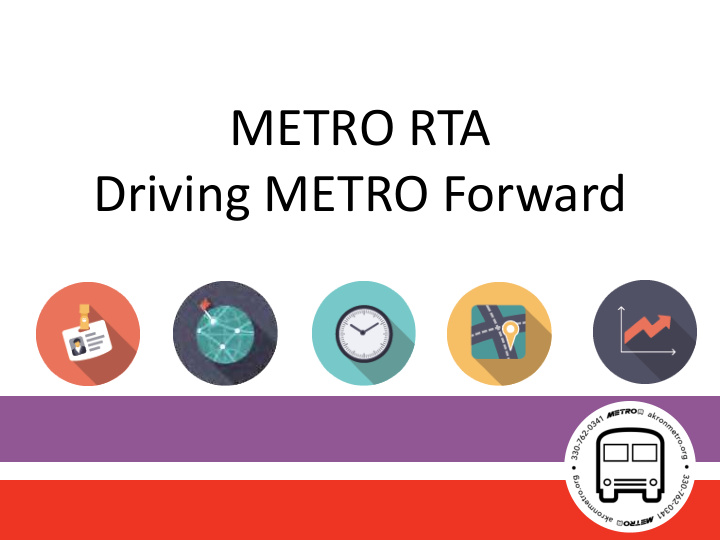



METRO RTA Driving METRO Forward
METRO’s Mission METRO Regional Transit Authority enhances the quality of life for our community by providing innovative transportation solutions that are safe, dependable, cost-effective and customer-focused …now and into the future. The goal of this process is to hear from you how we can build a better system while being good stewards of your tax dollars.
Guiding Principles Match Service to Modern Travel Patterns Strengthen Network Structure Simplify the Routes Foster a Transit-First Lifestyle Build Financial Stability
Match Service to Modern Travel Patterns Problem: The current bus system was designed around the commuting patterns of the past and must be updated to reflect where and when jobs and services are located now. Goal: Place bus service where it will benefit the largest number of likely transit users. METRO’s Thoughts: We need to adjust routes and schedules to reflect where people and jobs have moved since the last major change in the late 1990s. In 2013, only 53% of METRO trips were work trips. This is significantly less than most transit agencies. Therefore, we need to tailor our service to more than just work. METRO provides basic mobility for school, shopping, medical, and many other trip purposes.
Match Service to Modern Travel Patterns Population Density 2010 Census 2000 Census Population Density is one of the best predictors of transit usage.
Match Service to Modern Travel Patterns 76% of businesses with greater than 20 employees are within ¼ mile of METRO line service.
Strengthen Network Structure Problem: METRO’s radial network, traditionally focused on Downtown Akron, makes cross-county or even neighborhood- to-neighborhood trips slow and difficult. Goal: Design routes so that connections are possible outside of downtown. Adopt an everywhere to everywhere model in the urban core. METRO’s Thoughts: Many mid-size transit systems have moved from a downtown-focused radial system to a grid- based system. Grid based systems generally require more transferring (which passengers do not like), but are more frequent and have faster travel times (which passengers love).
Strengthen Network Structure Radial Network Grid Network - One-seat rides - More transfers - No cross-town trips - Anywhere to anywhere - Duplication of service on 2 buses near downtown - Less focus on downtown
Simplify the Routes Problem: METRO’s current routing and schedule is highly customized. Our system is very difficult for first-time or casual users to learn. Goal: Simplify the system map with more direct routing so that it is obvious where the bus is going. Simplify the schedule with clockface headways. For example “This bus comes every half hour.” METRO’s Thoughts: Currently, we have several “lineups” or “pulses” during peak commuting times. Lineups should be regular and consistent throughout the day, for example every two hours, in order to make transfers more uniform and predictable.
Simplify the Routes Clockface Headways Custom Scheduling
Simplify the Routes #4 has five different “patterns” #30 takes the same path every trip In which neighborhood is it easier to learn to ride the bus?
Enable a Transit First Lifestyle Problem: Currently, there is nowhere in Summit County with frequent transit service throughout the day 7 days a week. Goal: Increase the frequency and service span on routes in transit-supportive (dense, walkable, mixed use) areas to allow greater flexibility in trip planning, shorter wait times, and ultimately the ability to live without a car. METRO’s Thoughts: Core neighborhoods along the #1 and #2 approach this standard, but we can do much better. The 2012 Master Plan outlined priority corridors for high-frequency bus service. Committing additional service in these corridors should increase ridership and could promote neighborhood revitalization.
Enable a Transit First Lifestyle This high-frequency network was proposed in METRO’s 2012 Master Plan. It consists of METRO’s five most productive routes at that time. Does this network still make sense? Has anything changed?
Enable a Transit First Lifestyle This map shows productivity by segment on METRO’s most productive routes . Most of these route segments are already very productive, and would likely generate additional ridership if buses were available more frequently. Most of these segments match those identified for high-frequency service in 2012.
Build Financial Stability Problem: METRO’s farebox recovery ratio (percent of operating cost covered by fares) was 11.1%. METRO’s peer systems averaged 19.4% in 2012. Goal: Provide more service to more riders for the same amount of money. Although METRO is financially strong due to the Summit County sales tax voters passed in 2008, we can do better to put our resources where they benefit the most people. METRO’s Thoughts: Other systems have been able to add additional service miles without additional cost by going through a similar process. Omaha METRO was able to offer 3% more service for no extra operating cost.
Build Financial Stability Since 2005, METRO has increased service hours on line service buses 22%. • In 2015, buses ran over 58,000 more hours than in 2005. • Operating costs directly follow service hours. • Ridership has not responded to the increase in service hours • Although it has rebounded since service cuts in 2008-2009, • ridership in 2015 was nearly 400,000 rides lower in 2015 than in 2008
Build Financial Stability In 2007, most of METRO’s routes could be considered “Most • Productive” or “Productive”
Build Financial Stability Problem: Many routes have become less productive. Also, the hours we have added • have not resulted in additional ridership.
What’s Next? Many other large and mid-sized transit systems have found themselves in a similar place • recently. High-frequency network before High-frequency network after
What do you think of our guiding principles? Match Service to Modern Travel Patterns Strengthen Network Structure Simplify the Routes Foster a Transit-First Lifestyle Build Financial Stability How can we reach these goals? What would success look like?
Recommend
More recommend